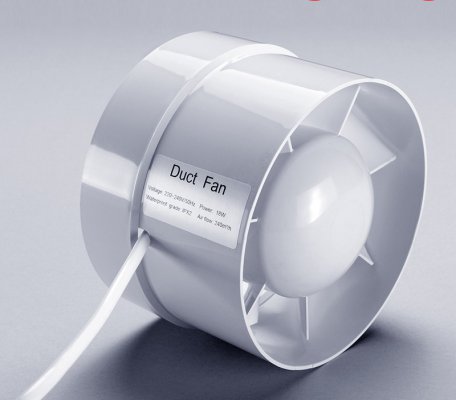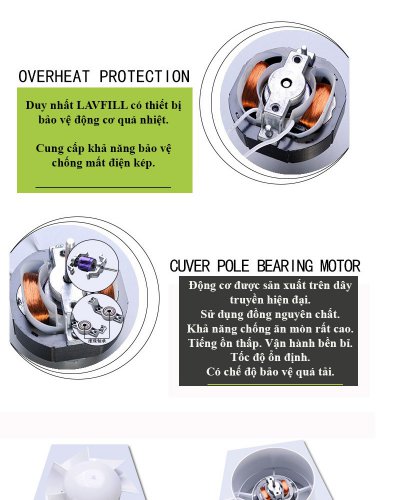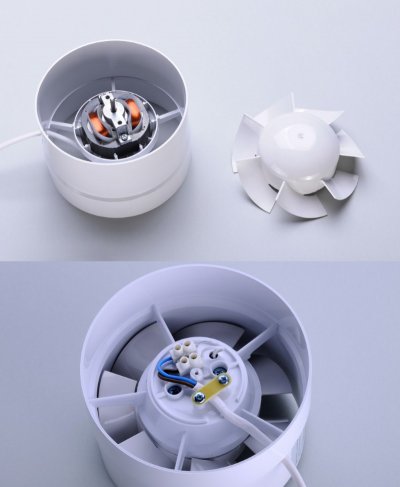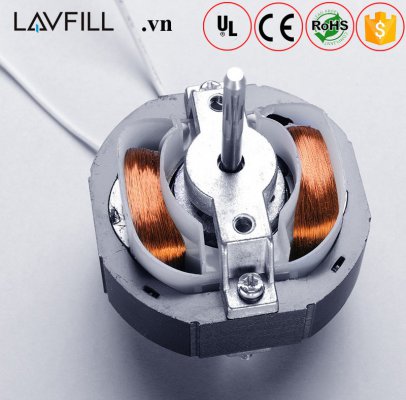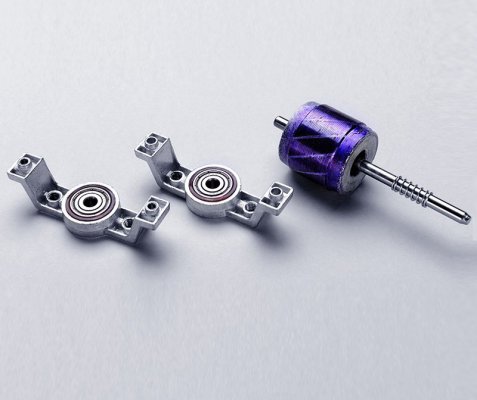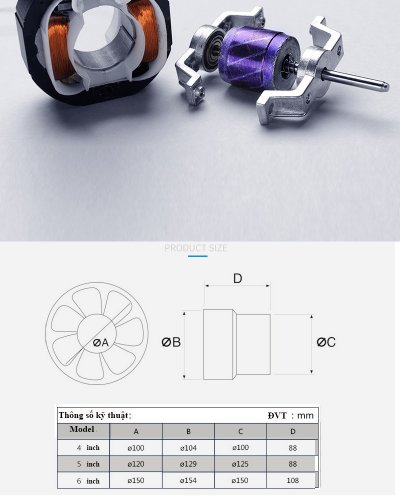Looking for a home UPS that is smart
- Thread starter blr_p
- Start date
You are using an out of date browser. It may not display this or other websites correctly.
You should upgrade or use an alternative browser.
You should upgrade or use an alternative browser.
rdst_1
Juggernaut
Just that you know, the load sharing between utility and solar/battery works like this. Suppose the 5kw solar array is putting out 3kw at a particular time, if the load now is more like 3.5kw, it will take the remaining from battery. If the battery is also depleted or if no battery is connected then it will change over completely to the utility , where it will take 3.5kw from the utility until the load drops below 3kw at which point it will revert back to solar, in the same time while the load is being power by utilty, it will charge the battery using solar only(if set in menu).
The super duper expensive Grid tie smart hybrid flin models on the other hand in the same situation above with 5kw solar array and 3kw output , the 3.5kw load will now only take 500w from the grid. The problem with this model is that it cannot export power to the grid because it's not MNRE approved and it also cannot handle surge/start up current like the off grid models such as Flinfuzion.
This is from the Flinfuzion manual -
However, when selecting output source priority it seems to contradict this statement. I am not entirely sure.Operating Mode - Line Mode
If 'solar first' is selected as output source priority and solar energy is not sufficient to provide the load, solar energy and the utility will provide the loads and charge the battery at the same time.
Solar first - Utility provides power to loads only when any one condition happens:
a) Solar Energy is not available
b) Battery voltage drops to low-level warning voltage.
SBU priority - Utility provides power to loads only when battery voltage drops to low-level.
What is your source that says that actual load sharing doesn't occur. I think this needs some clarification from the manufacturers.
Edit - I have asked them to explain this in detail on the Amazon product page.
I have the model and manual in my hand and yes it does state that,(my unit is not yet connected its WIP) and I won't be installing solar for another 2 quarters.This is from the Flinfuzion manual -
However, when selecting output source priority it seems to contradict this statement. I am not entirely sure.
What is your source that says that actual load sharing doesn't occur. I think this needs some clarification from the manufacturers.
Edit - I have asked them to explain this in detail on the Amazon product page.
I have read post in some forum which had detailed discussion about this and I remember positively that the unit simply will turn On the Grid input relay, if the load consumption is higher then what solar/battery can give.
Compared to their other range the Fuzion version works without battery and accepts solar voltage range compatible with Desi and other MNRE aprroved grid tie/feed inverters.
Last edited:
If you plan to install solar, I would go with flin fuzion range which has MPPT charge controller read my previous post in this thread. If you are sure you will never use solar and just want to use it like a ups/inverter,then you can go for their PWM models, it also has support for solar panels but is not efficient for solar.so which model makes most sense for home usage?I also went through their range but it was confusing.
Their On grid or Grid feed in inverters are NOT MNRE approved, so they cannot be used for exporting power to the grid.
rdst_1
Juggernaut
It will be interesting to see their response. I think you will be proven right because their Infini Smart Hybrid 5kVA model is for 99k and I am guessing higher price is for that reason apart from on-grid facility. In the Infini series description, it clearly states that it will only only seek additional input from the grid when load is higher.I have the model and manual in my hand and yes it does state that,(my unit is not yet connected its WIP) and I won't be installing solar for another 2 quarters.
I have read post in some forum which had detailed discussion about this and I remember positively that the unit simply will turn On the Grid input relay, if the load consumption is higher then what solar/battery can give.
Compared to their other range the Fuzion version works without battery and accepts solar voltage range compatible with Desi and other MNRE aprroved grid tie/feed inverters.
How much did you buy your Flin Fuzion for and from where? Are prices on Amazon cheaper as they are selling directly or are there other options. I saw a few reviews where the guy says that he had to send his back for repair after 10 months and they don't have any service centres. He was from Kolkata and it took them 24 days to receive, repair and return the inverter. That's too long if one is dependent on solar for most of their usage.
Bought it from amazon with cash back, the prices have dropped now, so not much difference between cash back and current price.
As far as service majority of the brands here except luminous and sukam just rebadge chinese or taiwan inverters.So the lead time for repair will be the same for any other brands other then pure indian made(not indian assembled) desi companies.
If the warranty period is over and then if the pcb board does go kaput, the main OEM in taiwan or their subsidy company in china can air ship it via DHL or similar. You will off course be hit with customs. Many just find a good soldering guy and replace the kaput components like a IGBT, mosfits, capacitors(pretty cheap, wont cost more then 500 to 1000). Only if a transformer or a transformer type inductor goes bad will the need to replace the entire board.
Most common reasons for components to go kaput poor maintenance like not cleaning leading to increased temperature, shorting the battery or other wires be it Ac or DC, utility surge/high voltage/lightning, keeping the battery voltage to near its max setting in the menu which is very close to the max tolerance of the capacitors used.
Of course the vast majority of these inverters have been running fine in western countries for several years 24/7, so much so that they don't have any other grid options other then a generator. In India the conditions are different poor grid voltage and (lots of dust and higher temperature, I doubt it applies to your natural air conditioned climate).
In the self made Ac combiner box that I made, I have put a voltage cut off device for added protection, will also put some SPD(surge protection device).
As far as service majority of the brands here except luminous and sukam just rebadge chinese or taiwan inverters.So the lead time for repair will be the same for any other brands other then pure indian made(not indian assembled) desi companies.
If the warranty period is over and then if the pcb board does go kaput, the main OEM in taiwan or their subsidy company in china can air ship it via DHL or similar. You will off course be hit with customs. Many just find a good soldering guy and replace the kaput components like a IGBT, mosfits, capacitors(pretty cheap, wont cost more then 500 to 1000). Only if a transformer or a transformer type inductor goes bad will the need to replace the entire board.
Most common reasons for components to go kaput poor maintenance like not cleaning leading to increased temperature, shorting the battery or other wires be it Ac or DC, utility surge/high voltage/lightning, keeping the battery voltage to near its max setting in the menu which is very close to the max tolerance of the capacitors used.
Of course the vast majority of these inverters have been running fine in western countries for several years 24/7, so much so that they don't have any other grid options other then a generator. In India the conditions are different poor grid voltage and (lots of dust and higher temperature, I doubt it applies to your natural air conditioned climate).
In the self made Ac combiner box that I made, I have put a voltage cut off device for added protection, will also put some SPD(surge protection device).
Last edited:
Who can tell me if this AC extractor fan uses a brushless motor ?
View attachment 80595View attachment 80596View attachment 80597View attachment 80598View attachment 80599View attachment 80600View attachment 80601
Aren't (almost) all AC motors brushless? This is in all likelihood a single phase squirrel cage induction motor. I don't see a phase spitting capacitor or a starter coil, but that may be because it will rely on the air flowing through the duct to start it.
blr_p
Quasar
You may have a point thereAren't (almost) all AC motors brushless? This is in all likelihood a single phase squirrel cage induction motor. I don't see a phase spitting capacitor or a starter coil, but that may be because it will rely on the air flowing through the duct to start it.


Tesla Polyphase Induction Motors | AC Motors | Electronics Textbook
Read about Tesla Polyphase Induction Motors (AC Motors) in our free Electronics Textbook
As compared to a DC motor armature, there is no commutator. This eliminates the brushes, arcing, sparking, graphite dust, brush adjustment and replacement, and re-machining of the commutator.
let's see if more agree but it seems like this fan will be safe to vent hydrogen
blr_p
Quasar
Its not a DC motor, its AC, with a speed regulator and a plug. And from what i've understood AC motors are by default, brushlessIt doesn't look like it's brushless DC, more like a induction motor. A bldc motor will have permanent magnets and will cost much more.
A brushless motor will put out a lot more airflow or consume lesser watts for the same air flow compared to the above specs.
Much easier to put this on a timer if i can figure out what time it should come on.
Is there a way to figure this out with the flin ?
Ac motors come in brushed form also, I said Brushless DC motors in this context( a Ac input first convert to DC and then convert it back to AC). There is also a EC exhaust fan with the electronics so tiny that it doesn't look any different from a regular PC fan, but works on Ac and is brushless, so good for 24/7 with bearings life of 50k hours.
Some models of Flin particulatly the ones which work with low solar panel volage has a relay with both NC and NO connections which you can program to say control the a seperate AC relay after a set certain battery voltage is reached. But its of little use since h2 gas in produced 24/7 including float charge.
One needs only 4% of H2 concentration in air for combustion. So internationally recommended safe zone is keep it at 1% or less. After some head scratching calculation using the formulas in the attached pdf, worth reading fully.
I my case a battery box will have much lesser space compared to a dedicated battery room and the battery box has even less area internally after the battery themself occupy the cubic feet area inside. So I calculated that for my battery box one needs around 20 seconds to reach the 1% rule when charging at c10, so (timer is useless)its best to put a 60cfm running 24/7 at 5watt power consumtion and you put the air flow to duct, the sheer air flow will carry the h2 out the window. That way I have a comfortable margin.
Timer would have worked if connected to solar, that way you can set it to run at 8:30 am to 4:30pm when batteries are getting charged via solar. Without solar when charging via Ac, the batteries are always in float charge and they keep releasing H2.
Some models of Flin particulatly the ones which work with low solar panel volage has a relay with both NC and NO connections which you can program to say control the a seperate AC relay after a set certain battery voltage is reached. But its of little use since h2 gas in produced 24/7 including float charge.
One needs only 4% of H2 concentration in air for combustion. So internationally recommended safe zone is keep it at 1% or less. After some head scratching calculation using the formulas in the attached pdf, worth reading fully.
I my case a battery box will have much lesser space compared to a dedicated battery room and the battery box has even less area internally after the battery themself occupy the cubic feet area inside. So I calculated that for my battery box one needs around 20 seconds to reach the 1% rule when charging at c10, so (timer is useless)its best to put a 60cfm running 24/7 at 5watt power consumtion and you put the air flow to duct, the sheer air flow will carry the h2 out the window. That way I have a comfortable margin.
Timer would have worked if connected to solar, that way you can set it to run at 8:30 am to 4:30pm when batteries are getting charged via solar. Without solar when charging via Ac, the batteries are always in float charge and they keep releasing H2.
Attachments
blr_p
Quasar
So you're saying this extractor fan isn't suitable to vent hydrogen ?It doesn't look like it's brushless DC, more like a induction motor. A bldc motor will have permanent magnets and will cost much more.
A brushless motor will put out a lot more airflow or consume lesser watts for the same air flow compared to the above specs.
blr_p
Quasar
Can you post a link to it ?There is also a EC exhaust fan with the electronics so tiny that it doesn't look any different from a regular PC fan, but works on Ac and is brushless, so good for 24/7 with bearings life of 50k hours.
It will work not the most efficient though for the price.So you're saying this extractor fan isn't suitable to vent hydrogen ?
Plenty of EC fan 90 to 120mm but with 38mm depth Pc style fans in aliexpress. In India you do get a chinese rebadged fan with lower RPM like this http://www.maa-ku.com/index.php?route=product/product&path=66&product_id=55
blr_p
Quasar
So how about something simpler. NO FAN! aka passive ventilationAc motors come in brushed form also, I said Brushless DC motors in this context( a Ac input first convert to DC and then convert it back to AC). There is also a EC exhaust fan with the electronics so tiny that it doesn't look any different from a regular PC fan, but works on Ac and is brushless, so good for 24/7 with bearings life of 50k hours.
Some models of Flin particulatly the ones which work with low solar panel volage has a relay with both NC and NO connections which you can program to say control the a seperate AC relay after a set certain battery voltage is reached. But its of little use since h2 gas in produced 24/7 including float charge.
One needs only 4% of H2 concentration in air for combustion. So internationally recommended safe zone is keep it at 1% or less. After some head scratching calculation using the formulas in the attached pdf, worth reading fully.
I my case a battery box will have much lesser space compared to a dedicated battery room and the battery box has even less area internally after the battery themself occupy the cubic feet area inside.
So I calculated that for my battery box one needs around 20 seconds to reach the 1% rule when charging at c10, so (timer is useless)its best to put a 60cfm running 24/7 at 5watt power consumtion and you put the air flow to duct, the sheer air flow will carry the h2 out the window. That way I have a comfortable margin.
Timer would have worked if connected to solar, that way you can set it to run at 8:30 am to 4:30pm when batteries are getting charged via solar. Without solar when charging via Ac, the batteries are always in float charge and they keep releasing H2.

Check out this guy's box. He has 14 batteries
I'm still trying to understand how it works. But it apparently does.
Here is a video by another guy using the same design of concentric pipes. Another video using PVC pipes.
I read the below in a book
I will have a two battery series setup, yours will be four batteries. Guess what if we use 200AH batteries, both our systems have the same capacity for Ah.Hydrogen is very easily diluted by air, and in small installations (< 100 Ah) it is not always necessary to use fans if the space is equipped with inlet and outlet air vents.
Attachments
I saw his design a while back. But for the passive design to work lots of piping needs to be done. That pdf also says to use thermaly conductive pipes and copper is expensive, Every seal including the wire holes have to be sealed properly.
With a active system, you just need two holes with one hole covered with a Rs50 filter sizes of 80,92,120mm etc are available readily in market and in the other side you install the fan in pull air to the duct/pipe.
Since mine will be mounted below stair case, which has a window from right side of the battery box. Above the battery box is the inverter mounted on a Hylam/bakelite board (p4 grade or atleast thats what the dealer said)all supported by slotted angle legs.
The vent hole in the window(glass pane replaced with fiber/plastic translucent sheet, which doesn't look that different from a glass pane) is located to right side of the inverter and battery box.
When the battery fan is running, it will blow the air to the outside, in doing so it will also create a negative pressure in the vent hole in the window, which will be Y or T shaped pipe joint, such that the warm air blown by the built in inverter fans will be sucked by the negative air pressure to the outside. One hole of Y shaped is connected to the battery fan pipe or flexible duct, the other hole to the window, the third hole will suck the hot air from the inverter.
So my update progress so far is, I personally changed the wiring modified to accommodate the inverter input and output, which was done in the utility meter board wearing some 11kv rated gloves, Added a SPD(must for inverter warranty) and voltage cut off device, higher amp rated rcbo, HRC fuses etc.
Also did the hylam board where the inverter would be mounted, populated with switches,mcb,sockets, display for balancer and battery monitor etc)
Zero physical outside help was needed so far, hence the work takes a long time do, especially with almost zero help from family members (hot weather put me off), but making the battery box is going to be a challenge and may get it done via a carpenter.
So far spent in excess of 25k just for the wires, heavy duty battery cable , mcb, ACCB enclosure, battery monitor, equalizer, wood for battery box, wire ducts, Heavy duty crimping tools, bootlace ferrules and its dedicated crimping tool, terminal blocks etc chewed through 4 genuine bosch drill bits, for making holes in Hylam board.
Still to do battery box and to purchase battery,fans and do the final cable runs.
With a active system, you just need two holes with one hole covered with a Rs50 filter sizes of 80,92,120mm etc are available readily in market and in the other side you install the fan in pull air to the duct/pipe.
Since mine will be mounted below stair case, which has a window from right side of the battery box. Above the battery box is the inverter mounted on a Hylam/bakelite board (p4 grade or atleast thats what the dealer said)all supported by slotted angle legs.
The vent hole in the window(glass pane replaced with fiber/plastic translucent sheet, which doesn't look that different from a glass pane) is located to right side of the inverter and battery box.
When the battery fan is running, it will blow the air to the outside, in doing so it will also create a negative pressure in the vent hole in the window, which will be Y or T shaped pipe joint, such that the warm air blown by the built in inverter fans will be sucked by the negative air pressure to the outside. One hole of Y shaped is connected to the battery fan pipe or flexible duct, the other hole to the window, the third hole will suck the hot air from the inverter.
So my update progress so far is, I personally changed the wiring modified to accommodate the inverter input and output, which was done in the utility meter board wearing some 11kv rated gloves, Added a SPD(must for inverter warranty) and voltage cut off device, higher amp rated rcbo, HRC fuses etc.
Also did the hylam board where the inverter would be mounted, populated with switches,mcb,sockets, display for balancer and battery monitor etc)
Zero physical outside help was needed so far, hence the work takes a long time do, especially with almost zero help from family members (hot weather put me off), but making the battery box is going to be a challenge and may get it done via a carpenter.
So far spent in excess of 25k just for the wires, heavy duty battery cable , mcb, ACCB enclosure, battery monitor, equalizer, wood for battery box, wire ducts, Heavy duty crimping tools, bootlace ferrules and its dedicated crimping tool, terminal blocks etc chewed through 4 genuine bosch drill bits, for making holes in Hylam board.
Still to do battery box and to purchase battery,fans and do the final cable runs.
blr_p
Quasar
Another even simpler idea. No box. No fans. No pipes. Just vents. Inlet coming into the staircase room at the bottom and outlet vent leading outside at the top. Vent sizes would have to be calculated based on number of batteries. The UPS would also be in the same staircase room.I saw his design a while back. But for the passive design to work lots of piping needs to be done. That pdf also says to use thermaly conductive pipes and copper is expensive, Every seal including the wire holes have to be sealed properly.
I found a study that compared natural ventilation to mechanical and found the natural way superior.
Ventilation System Influence on Hydrogen Explosion Hazards in Industrial Lead-Acid Battery Rooms
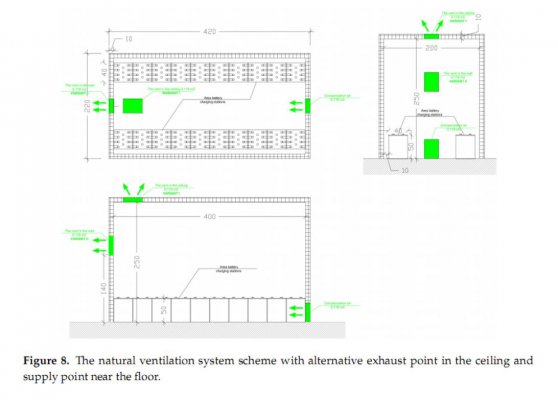
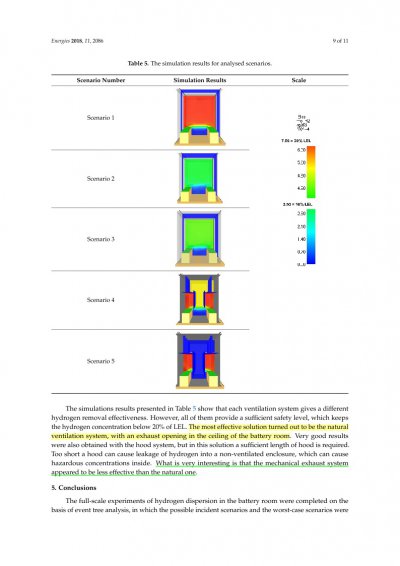
Scenarios 2 & 3 are an outlet in the roof and on the side. The hydrogen concentration is lowest in these two scenarios.
Very curious is scenario 1 which has a fan on the roof. This was the worst of the lot.
Last edited:
The problem with no box is very simple, In India it's very dusty, dust will settle on the petroleum jelly and when filling distill water its PIA to clean the dust off, of the vents and when you do try to dust it off one has to be extremely careful since the plastic would have now become brittle after a few years. I have 3 broken vent caps and found no replacements. Dust once it goes inside the battery fill hole will contaminate it.
Second issue is that for my use there are 4 batteries connected in series, that's a lethal DC voltage, if some one accidentally touches them like Kids and even pets, risk of lead poisoning and electrocution.
I have a window right side of both the inverter and battery box and that window is very near only 1 feet away (and window size is big 4' H x 1.5'w ). So for me all i would have to do is open the window. But doing so will cause the inverter to suck all the dust from outside. So its best to use active ventilation with filters for battery box.
Battery and it's cables are a ugly site, so the box hides them.
Second issue is that for my use there are 4 batteries connected in series, that's a lethal DC voltage, if some one accidentally touches them like Kids and even pets, risk of lead poisoning and electrocution.
I have a window right side of both the inverter and battery box and that window is very near only 1 feet away (and window size is big 4' H x 1.5'w ). So for me all i would have to do is open the window. But doing so will cause the inverter to suck all the dust from outside. So its best to use active ventilation with filters for battery box.
Battery and it's cables are a ugly site, so the box hides them.
Last edited:
blr_p
Quasar
Reason i was thinking of no box is because the stair case room (room is really a misnomer, in my case its like a crawl space under the stair case about 80 cubic foot) IS a box. I have no windows there and will have to make a hole in the wall. How big depends on venting calculations. I was thinking to just put the two batteries in those trolleys like Luminous with open backs touching. This covers up wires which is a good idea for safety reasons as you mentioned. It will also to some extent keep dust away. But the vent low on the door will bring in dust. Maybe i need to put a thin sponge filter on the vent.The problem with no box is very simple, In India it's very dusty, dust will settle on the petroleum jelly and when filling distill water its PIA to clean the dust off, of the vents and when you do try to dust it off one has to be extremely careful since the plastic would have now become brittle after a few years. I have 3 broken vent caps and found no replacements. Dust once it goes inside the battery fill hole will contaminate it.
Second issue is that for my use there are 4 batteries connected in series, that's a lethal DC voltage, if some one accidentally touches them like Kids and even pets, risk of lead poisoning and electrocution.
I have a window right side of both the inverter and battery box and that window is very near only 1 feet away (and window size is big 4' H x 1.5'w ). So for me all i would have to do is open the window. But doing so will cause the inverter to suck all the dust from outside. So its best to use active ventilation with filters for battery box.
Battery and it's cables are a ugly site, so the box hides them.
This is how most people have their setups in the country. Battery in a trolley in some well ventilated room. Where is the dust problem ?
People who make battery boxes usually have them in bigger rooms or its outside in cold climate and the box acts as insulation to keep temperature constant.
The problem with fans is what if it fails. You need redundancy. So think of two fans. One next to the other. Second is a backup that switches on in case the first fails. Where is the control logic to do this. How will you know if the fan fails and if fans is the only way to ventilate then its a risk.
Simpler is no fans but i've yet to be convinced that this will work. I'm not sure how the air changes work in such a situation. Vent area gives some idea how much air can come in and exit but nothing about the rate at which the flow occurs.



